
Ball Ground is a city in Cherokee County, Georgia, United States. The city was originally Cherokee territory before they were removed from the land and it was given to white settlers. A railroad was built in 1882 and a town was formed around the resulting railroad stop. The town was incorporated on January 1, 1883, and became an industrial-based economy largely centered around its marble industry until around the mid-20th century when the industries began to leave and the city started to decline. From 2000 onwards the city saw rapid growth; as of the 2020 census the city had a population of 2,560, which is over three times the city's population of 730 in 2000.

Alpharetta is a city in northern Fulton County, Georgia, United States, and part of the Atlanta metropolitan area. As of the 2020 U.S. census, Alpharetta's population was 65,818; in 2010, the population had been 57,551.

Roswell is a city in northern Fulton County, Georgia, United States. At the official 2020 census, the city had a population of 92,883, making Roswell the state's ninth largest city. A suburb of Atlanta, Roswell has an affluent historic district.
The Atlanta History Center is a history museum and research center located in the Buckhead district of Atlanta, Georgia. The Museum was founded in 1926, and has a large campus featuring historic gardens and houses, including Swan House, Smith Farm, and Wood Family Cabin. Atlanta History Center's Midtown Campus includes the Margaret Mitchell House & Museum. Atlanta History Center holds one of the largest collections of Civil War artifacts in the United States.
From its incorporation in 1847, the municipal boundaries of Atlanta, Georgia, United States, were extended repeatedly from a small area around its railroad station to today's city covering 131.7 square miles (341 km2).

Brookhaven, formerly North Atlanta, is a city in the northeastern suburbs of Atlanta that is located in western DeKalb County, Georgia, United States, directly northeast of Atlanta. On July 31, 2012, Brookhaven was approved in a referendum to become DeKalb County's 11th city. Incorporation officially took place on December 17, 2012, on which date municipal operations commenced. The new city stretches over 12 square miles (31 km2). With a population of 56,795 as of the 2020 census, it is the second largest city located fully within DeKalb County, behind Stonecrest.
The Alfred B. Maclay State Gardens is a 1,176-acre (4.76 km2) Florida State Park, botanical garden and historic site, located in Tallahassee, in northeastern Florida. The address is 3540 Thomasville Road.
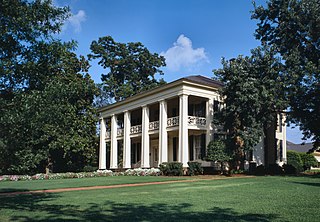
Arlington Antebellum Home & Gardens, or Arlington Historic House, is a former plantation and 6 acres (24,000 m2) of landscaped gardens near downtown Birmingham, Alabama. The two-story frame structure was built by enslaved people between 1845–50. Its style is antebellum-era Greek Revival architecture. The house serves as a decorative arts museum, featuring a collection of 19th-century furniture, textiles, silver, and paintings. The garden features a restored garden room that is used for special events. The house was added to the National Register of Historic Places on December 2, 1970, as Arlington, and has also been known as the Mudd-Munger House.
Joseph Neel Reid, also referred to as Neel Reid, was a prominent architect in Atlanta, Georgia, in the early 20th century as a partner in his firm Hentz, Reid and Adler.

The Georgia Trust for Historic Preservation is the United States' largest statewide, nonprofit preservation organization with more than 8,000 members. Founded in 1973 by Mary Gregory Jewett and others, the Trust is committed to preserving and enhancing Georgia's communities and their diverse historic resources for the education and enjoyment of all.

Emily Frances Gordy Dolvin, also known as Aunt Sissy, was an American educator, historic preservationist, political campaigner and civic leader from the state of Georgia.
The Autrey Mill Nature Preserve & Heritage Center is located in Johns Creek, Georgia, United States.
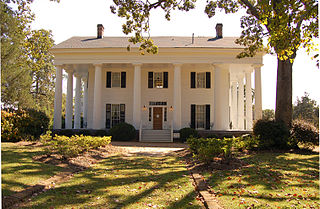
Barrington Hall is an 1842 Greek Revival-style plantation home, likely built by enslaved Africans and African Americans. It was the residence of Barrington King who, along with his father Roswell King, was the founder of the town of Roswell, in northern Fulton County, Georgia. The house was designed by Willis Ball. It was held by the family until 1995 and is listed on the National Register of Historic Places.

Antebellum architecture is the neoclassical architectural style characteristic of the 19th-century Southern United States, especially the Deep South, from after the birth of the United States with the American Revolution, to the start of the American Civil War. Antebellum architecture is especially characterized by Georgian, Neo-classical, and Greek Revival style homes and mansions. These plantation houses were built in the southern American states during roughly the 30 years before the American Civil War; approximately between the 1830s to 1860s.
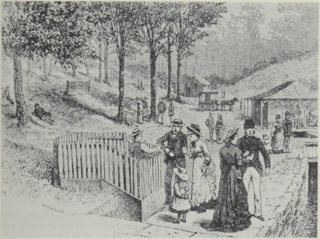
Ponce de Leon Springs was a mineral spring in Atlanta, Georgia, in the United States. The spring was a popular tourist destination from the mid-1800s through the early 1900s. Around the turn of the century, the land surrounding the spring was developed into an amusement park. By the 1920s, the amusement park was demolished, and the area was developed for industrial and, later, commercial properties.

Hills and Dales Estate is the home built for textile magnate Fuller Earle Callaway and his wife Ida Cason Callaway completed in 1916 in Lagrange, Georgia. The property includes the pre-Civil War Ferrell Gardens started by Nancy Ferrell in 1832 and expanded by her daughter Sarah Coleman Ferrell beginning in 1841.

The Reid House at 1325-1327 Peachtree St., NE, in Atlanta, Georgia, known also as Garrison Apartments and as 1325 Apartments, was built as a luxury apartment building in 1924. It was the third luxury apartment building built in Atlanta. It received a $2 million renovation during 1974 and was converted to a luxury condominium building in 1975. The ten-story building was designed by architect Philip T. Shutze of architectural firm Hentz, Reid and Adler in Classical Revival architecture. The 1974 renovation was by architect Eugene I. Lowry.
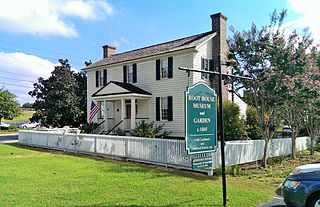
The Northwest Marietta Historic District is a 230-acre (93 ha) historic district in Marietta, Georgia that was listed on the National Register of Historic Places in 1975. It includes Late Victorian, Greek Revival, Plantation Plain, and other architecture. The district includes an area in downtown Marietta, with the southernmost point being south of Whitlock Avenue on McDonald Street, and runs out Kennesaw Avenue to Noses Creek in the northwest.
Glenridge Hall was a historic property in Sandy Springs, Georgia, United States. The house was built in 1929 and listed on the National Register of Historic Places in 1982. The site was demolished and delisted in 2015.
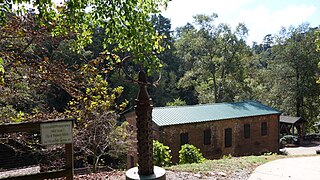
The Roswell Historic District, in Roswell, Georgia in Fulton County, was listed on the National Register of Historic Places in 1974.















